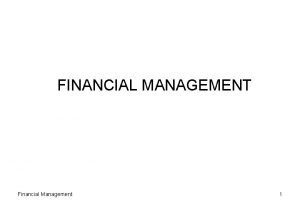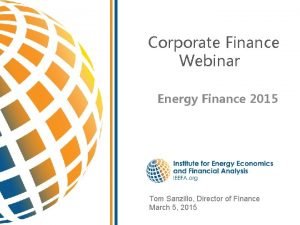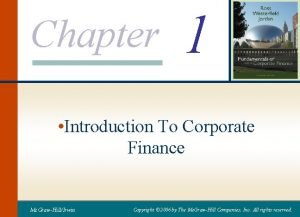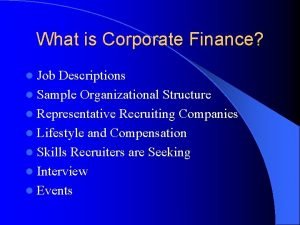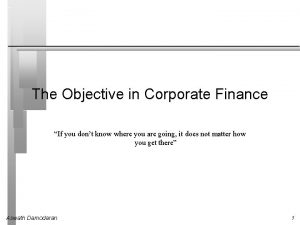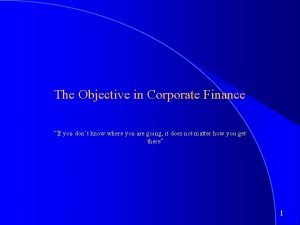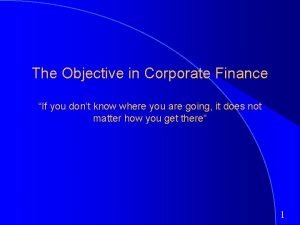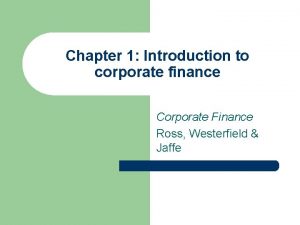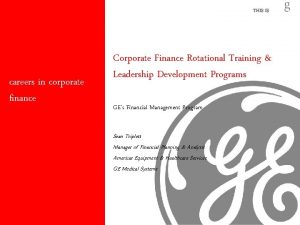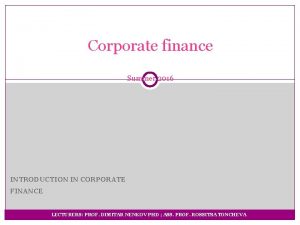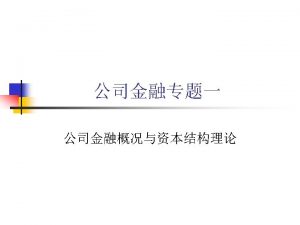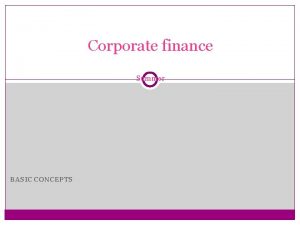Theory of Corporate Finance RWJChapter 1 What is









- Slides: 9

+ Theory of Corporate Finance RWJ-Chapter 1

+ What is Corporate Finance? n What long-term investments should the firm engage in? n n How can the firm raise money for the required investments? n n n Capital Budgeting: The process of planning and managing a firm’s longterm investments Investment opportunities: value vs. cost of these opportunities What do we need to learn? Capital Structure: The mixture of debt and equity to support long-term investments What do we know? And Why is important? How much short-term cash flow does a company need to pay its bills? n n Working Capital Management: Capital required for the firm’s day to day activities (current assets and liabilities) What do we know? And why is it important?

+ What is our Strategy? n We learn: n The basic tools to answer these questions n Financial Statements n Cost of Equity n Cost of Debt n Project Evaluation n Firm and Bond Valuations n To link these tools in our 3 fundamental questions n Moreover, corporate finance is a very important tool for investments? Why?

+ Let’s examine these questions in a Balance-Sheet Model The Capital Budgeting Decision Current Liabilities Current Assets Fixed Assets 1. Tangible 2. Intangible What long-term investments should the firm engage? Long-Term Debt Shareholders’ Equity

+ The Capital Structure Decision Current Liabilities Current Assets Fixed Assets 1. Tangible 2. Intangible How can the firm raise the money for the required investments? Long-Term Debt Shareholders’ Equity

+ The Net Working Capital Investment Decision Current Liabilities Current Assets Net Working Capital Fixed Assets 1. Tangible 2. Intangible How much short-term cash flow does a company need to pay its bills? Long-Term Debt Shareholders’ Equity

+ Goals of Financial Management n Maximize the current value of the firm. n n How can a financial manager do it? n Identify the best investments n Find the best financial arrangements (i. e. , best capital structure) Who are the owners of the firm? n Shareholders: “Residual Owners”

+ Agency Problem and Agency Cost n Agency problem exists whenever the principal hires another agent to represent his/her interest n Two types of agency problems: n n Between shareholders and managers (equity-related agency problems) n Between shareholders and bondholders (debt-related agency problems) Agency costs: the costs of devising appropriate incentives for managers and then monitoring their behavior

+ Agency Problem between Shareholders and Managers n n Managerial goals may be different from shareholder goals n Expensive perquisites n Risk aversion (managers might be more risk averse) n Free cash related problems (Hubris) How can shareholders control managerial behavior? n Directors (Board of Directors) n BOD can devise compensation plan to align the management incentives n BOD can also fire badly performing managers
 Objectives of corporate finance
Objectives of corporate finance Fundamentals of corporate finance chapter 6 solutions
Fundamentals of corporate finance chapter 6 solutions Modern corporate finance
Modern corporate finance Corporate finance webinar
Corporate finance webinar Corporate finance vs investment banking
Corporate finance vs investment banking Chapter 1 introduction to corporate finance
Chapter 1 introduction to corporate finance Corporate finance job scope
Corporate finance job scope Objective of corporate finance
Objective of corporate finance Objective of corporate finance
Objective of corporate finance Objective of corporate finance
Objective of corporate finance


